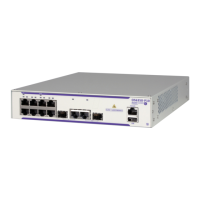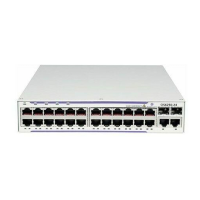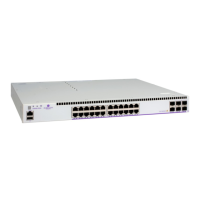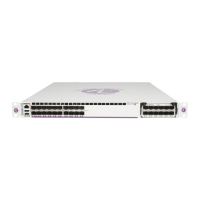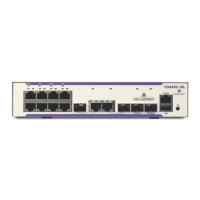Configuring QoS Traffic Policing and Shaping
OmniSwitch AOS Release 8 Network Configuration Guide December 2017 page 26-25
specify a peak information rate value that is greater than the committed information rate value. For
example, the following commands configure the meter to use the trTCM mode:
-> policy action A4 cir 10m cbs 4k pir 20m
-> policy action A5 cir 10m cbs 4k pir 20m pbs 40m
Once a TCM policy action is configured, the action can be used in a policy rule to rate limit traffic
according to the specified rates and burst sizes. Traffic that matches a TCM policy is marked green, red, or
yellow based on the rate limiting results.
To remove the TCM configuration from a QoS policy action, use the no form of the policy action cir
command. For example:
-> policy action A6 no cir
TCM Policy Example
Once configured, a TCM policy action is then available to use in a QoS policy rule to apply color marking
to a specified traffic stream.
First, create a condition for the traffic. In this example, the condition is called ip_traffic. A policy action
(tcm1) is then created to enforce ingress rate limiting using TCM.
-> policy condition ip_traffic source ip 10.10.5.3
-> policy action tcm1 cir 5m cbs 4k pir 10m pbs 20m counter-color green-nongreen
-> policy rule rule1 condition ip_traffic action tcm1
Note that the rates and burst sizes can be specified in abbreviated units, in this case, 10m.
The rule is not active on the switch until the qos apply command is entered. When the rule is activated,
any flows coming into the switch from source IP address 10.10.5.3 is metered and marked according to the
TCM policier parameters specified in the tcm1 policy action.
Setting the DEI Bit
The Drop Eligible Indicator (DEI) bit setting is applied to packets marked yellow (non-conforming) as the
result of Tri-Color Marking (TCM) rate limiting. The TCM policier meters traffic based on user-
configured packet rates and burst sizes and then marks the metered packets as green, yellow, or red based
on the metering results. See “Configuring Tri-Color Marking” on page 26-24 for more information.
Yellow packets are assigned a high drop precedence, which means they are dropped first when the egress
port queues become congested. If there is no congestion on the queues, however, yellow packets are
retained and forwarded along to the next switch. When this occurs, the receiving switch does not know
that the packet was marked yellow by the transmitting switch.
Setting the DEI bit for yellow egress packets ensures that the upstream switch is made aware that the
packet was marked yellow. The upstream switch can then decide to drop the DEI marked packets first
when the network is congested. When a switch receives a yellow packet with the DEI bit set and DEI
mapping is enabled, the packet is mapped to an internal drop precedence or yellow color marking for the
switch.
The switch can be set globally so that DEI bit marking and mapping is enabled for all ports. Individual
ports can be configured to override the global setting
Configuring the DEI Bit Setting
By default, DEI bit marking (egress) and mapping (ingress) is disabled on all switch ports. The DEI bit
setting operation can be configured globally on the switch, or on a per-port basis.

